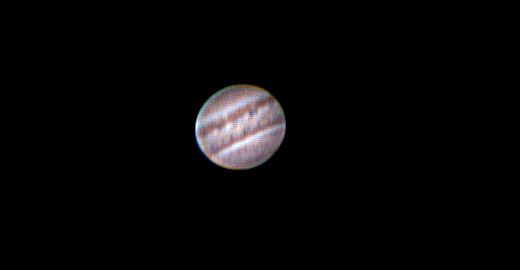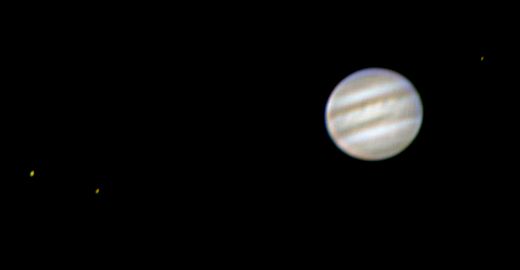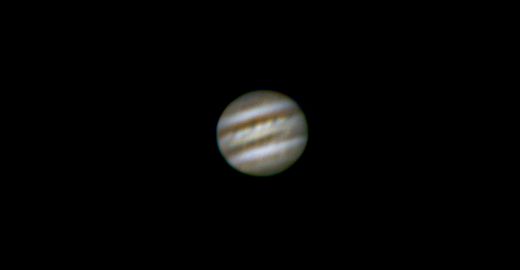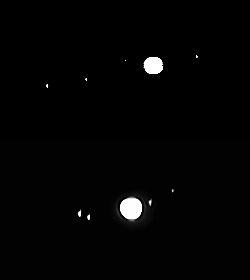

Although strictly speaking all these pictures were taken on 4th April, they do in fact cover 22 hours, so involve two consecutive nights. I present them in chronological order apart from the pair of images at the bottom illustrating the movements of the satellites.
 |
This was the first picture taken at 01:38 UT. This is often referred to as "the boring side" of Jupiter because the Great Red Spot is not to be seen. However, even at the resolution I can achieve, there is lots of detail in the cloud belts. Date and Time: 4th April 2006 01:38 UT Camera: ToUcam 740K Telescope: LX200 at prime focus Capture: K3CCDTools. Low gamma, 1/33", 27% gain, 431 frames Processing: Registax. 143 frames stacked. Wavelets 1 = 40, 2-3 = 10, histogram 50-180 |
 |
This picture was taken 23 hours after the one above, but Jupiter doesn't look very different. The reason is that Jupiter rotates in a little under 10 hours, so it had completed slightly more than two complete rotations in this time and was presenting almost the same face to us. The GRS was still round the back. This picture was exposed to capture both the planet's features and the major satellites which usually results in a rather bland picture of the planet itself (but see here). Move your mouse over the picture to see which they are. Date and Time: 4th April 2006 23:44 UT Camera: ToUcam 740K Telescope: LX200 at prime focus Capture: K3CCDTools. High gamma, 1/33", 2% gain, 352 frames Processing: Registax. 192 frames stacked. Wavelet 1-3 = 10, gamma 0.8, histogram 50-255 |
 |
This picture, taken a few minutes later, was exposed for the surface details of Jupiter. Although the picture was taken at the prime focus of my LX200, when I processed it I felt that the quality would support magnification. Move your mouse over the image to see the picture magnified by a factor of 2. Of course it would probably have been better to have used my X2 lens at the telescope but I hadn't! Date and Time: 4th April 2006 23:46 UT Camera: ToUcam 740K Telescope: LX200 at prime focus Capture: K3CCDTools. Low gamma, 1/50", 18% gain, 788 frames Processing: Registax. 303 frames stacked. Wavelet 1-3 = 10, histogram 10-200 |
 |
Finally these pictures were taken through my ST80 refractor in order to illustrate how the major satellites move over time. The top picture was taken at 01:30 UT and the lower one at 23:58. Move your mouse over the image to identify the satellites. In the 22½ hours between the pictures, Io, the fastest moving, had completed a little over half of its orbit around Jupiter so appears on the other side. Europa had completed only 26% of its orbit, but happened to have passed in front of the planet in that time, so also appears on the other side. Ganymede had completed only 13% of its orbit but can be seen to have approached the planet as seen from here. Lastly Callisto had completed only 6% of its orbit; it too had passed in front of the planet in that time and this gives the impression it has moved rather more than that, but it is considerably further from Jupiter than the other three satellites (and at this time nearer to us by a little bit too). Date and Time: 4th April 2006 times on the mouseover Camera: ToUcam 840K Telescope: ST80 piggybacked on the LX200 Capture: K3CCDTools. High gamma. 01:30: 1/33", 22% gain, 309 frames. 23:58: 1/25", 28% gain, 343 frames Processing: Registax. 01:30: 115 frames stacked. Wavelets 1 = 10, 2 = 5, histogram 70-255. 23:58: 140 frames stacked. Wavelets 1 = 10, 2 = 5, histogram 20-200 |